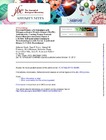Poxviral protein A52 stimulates p38 Mitogen-Activated Protein Kinase (MAPK) activation by causing tumor necrosis factor receptor-associated factor 6 (TRAF6) self-association leading to transforming growth factor b-activated kinase 1 (TAK1) recruitment
Citation
Stack, J. et al. Poxviral protein A52 stimulates p38 Mitogen-Activated Protein Kinase (MAPK) activation by causing tumor necrosis factor receptor-associated factor 6 (TRAF6) self-association leading to transforming growth factor b-activated kinase 1 (TAK1) recruitment. J. Biol. Chem. 2013, 288(47):33642-53.

View/
Date
2013Author
Stack, Julianne
Hurst, Tara P.
Flannery, Sinead M.
Brennan, Kiva
Rupp, Sebastian
Oda, Shun-ichiro
Khan, Amir R.
Bowie, Andrew G.
Peer Reviewed
YesMetadata
Show full item record
Stack, J. et al. Poxviral protein A52 stimulates p38 Mitogen-Activated Protein Kinase (MAPK) activation by causing tumor necrosis factor receptor-associated factor 6 (TRAF6) self-association leading to transforming growth factor b-activated kinase 1 (TAK1) recruitment. J. Biol. Chem. 2013, 288(47):33642-53.
Abstract
Vaccinia virus encodes a number of proteins that inhibit and manipulate innate immune signaling pathways that also have a
role in virulence. These include A52, a protein shown to inhibit IL-1- and Toll-like receptor-stimulated NF B activation, via
interaction with interleukin-1 receptor-associated kinase 2 (IRAK2). Interestingly, A52 was also found to activate p38 MAPK and thus enhance Toll-like receptor-dependent IL-10 induction, which was TRAF6-dependent, but the manner in which A52 manipulates TRAF6 to stimulate p38 activation was unclear. Here, we show that A52 has a non-canonical TRAF6- binding motif that is essential for TRAF6 binding and p38 activation but dispensable for NF B inhibition and IRAK2 interaction. Wild-type A52, but not a mutant defective in p38 activation and TRAF6 binding (F154A), caused TRAF6 oligomerization and subsequent TRAF6-TAK1 association. The crystal structure of A52 shows that it adopts a Bcl2-like fold and exists as a dimer in solution. Residue Met-65 was identified as being located in the A52 dimer interface, and consistent with that, A52-M65E was impaired in its ability to dimerize. A52-M65E although capable of interacting with TRAF6, was unable to cause either TRAF6 self-association, induce the TRAF6-TAK1 association, or activate p38 MAPK. The results suggest that an A52 dimer causes TRAF6 self-association, leading to TAK1 recruitment and p38 activation. This reveals a molecular mechanism whereby poxviruses manipulate TRAF6 to activate
MAPKs (which can be proviral) without stimulating antiviral NF B activation.
Keywords
Poxviral proteinA52
p38
Mitogen-Activated Protein Kinase (MAPK)
Tumor necrosis factor receptor-associated factor 6 (TRAF6)
Transforming growth factor b-activated kinase 1 (TAK1)
Recruitment
Growth
Language (ISO 639-3)
engPublisher
ASBMB [American Society for Biochemistry and Molecular Biology]License URI
http://www.jbc.org/content/288/47/33642.longRelated items
Showing items related by title, author, creator and subject.
-
Psychosocial factors related to children’s active school travel: A comparison of two European regions
Murtagh, Elaine; McMinn, David; Row, David A.; Murtagh, Shemane; Nelson, Norah M.; Čuk, Ivan; Atiković, Almir; Peček, Mojca; Breslin, Gavin; Murphy, Marie H. (Berkeley Electronic Press, 2014)Inequalities in health behaviors exist between regions of Europe, along a North West/South East axis. This study investigated whether prevalence of walking to school and associated psychosocial antecedents differed between ... -
Civil society participation volunteerism - A geographical analysis
; Younge, Ciara (Mary Immaculate College, University of Limerick, 2012)Civil Society Participation & Volunteerism: A Geographical Analysis. A Comparative Case Study of Limerick City & North Tipperary Active citizenship is expressed through participation in civil society and voluntary activity. ...

